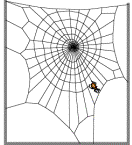 spun from the center outward. Without training from adults, even the
tiniest just-hatched spiderlings are able to spin silk and weave webs.
spun from the center outward. Without training from adults, even the
tiniest just-hatched spiderlings are able to spin silk and weave webs.
This time of year, everyone starts noticing spiders! Kids love to see spiders, even if they feel afraid. Use their energy to engage them in learning! Spiders belong to the class Arachnida, named after Arachne, a maiden in Greek mythology. She defeated the goddess Athena in a weaving contest. In a fury of anger, Athena destroyed Arachne's weaving and beat the girl about the head. In utter disgrace, Arachne hanged herself. A regretful Athena changed Arachne into a spider so that she could weave forever.

The orb weavers (garden, pumpkin, condo, debris spiders) are getting ready to make egg cases and some are already suspended from vegetation. The spiders have been around all summer, but the females have gotten much larger. This is also the time of year with warm days and cool nights that spiders begin ballooning.
Web building is a complex process: support lines are constructed
first; then the radial lines; and finally the spiraling strands are
 spun from the center outward. Without training from adults, even the
tiniest just-hatched spiderlings are able to spin silk and weave webs.
spun from the center outward. Without training from adults, even the
tiniest just-hatched spiderlings are able to spin silk and weave webs.
Spider silk: Did you know that there are 7 basic kinds? This is a great time of year to look at spider silk when you are in the field with the kids. See if you can find each different kind of silk:
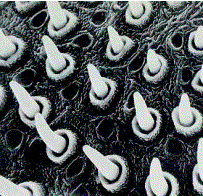
Silk comes out of the spider as a liquid and tension causes it to solidify. It is five times stronger than steel and about three times tougher than Kevlar. In the fall, garden spiders have spinnerets so large, you can spot them with your naked eye — they hang upside down in the center of the web for you to get a really good look.
In the Fall, the web becomes a less effective trap, and more time (think energy) is required to maintain the web. At the end of the season, spiders need more and more food-fuel to lay eggs. When the cost of web repair is no longer worth the energy taken away from reproduction, the web is shut down. As the season progresses, you can see fluff and seeds blown into the webs.
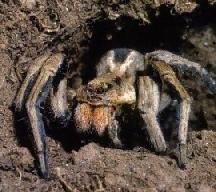
Wolf Spiders don't spin webs to entrap insects at all! The hunting strategies of wolf spiders are perhaps the most diverse of any spider group. Many are active, wandering hunters during the day, in sunny areas along the ground and in vegetation; others hunt at night and remain in silk-lined retreats during the day. Still others live and hunt in aquatic environments, walking on the surface of ponds or on submerged vegetation. Some wolf spiders dig burrows in which they lie in wait for passing insects and other prey. Of the spiders that dig burrows, some add a moveable trap door at the burrow entrance while others build an elevated lookout point.
The female wolf spider lays eggs in a large sac, which can be nearly as large as her own body. She attaches the egg sac to her body, and carries it until the eggs hatch. She then tears open the egg sac and the newly hatched spiders climb onto her back where they remain for up to a week.
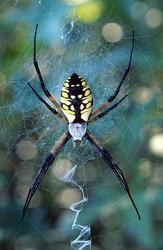
More interesting spider facts: Kids will love this! Having poor eyesight, orb weavers such as the garden spider, rely on a highly-developed sense of touch. When an insect becomes caught in the web and struggles, the spider is alerted by the vibrations. It rushes out to secure its prey, usually wrapping it in silk. A poison is injected into the victim, paralyzing it and converting the contents of its body to liquid. The spider returns later to insert its tube-like fangs and suck up its meal. Try catching a fly and feeding it to a garden spider.
The garden spider's profound sense of touch has another purpose: it provides male spiders with a channel to communicate with females. Before climbing onto the female's web, the male taps out a special message. Then he cautiously crawls toward his mate — a perilous task, for he is always in danger of being mistaken for prey. It is commonly thought that the female spider kills and eats the male after mating, but this is an exaggeration. The male, who stops eating during his mate-hunting ordeal, generally dies of malnourishment and exhaustion.
What do spiders eat? While they are certainly not going to win any
popularity contests, spiders' insect-eating habits are extremely
helpful to humans. Every year, billions of spiders do away with a
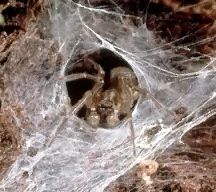 large number of disease-carrying and crop-destroying insects. If every
spider ate just one a day for a year, those insects, piled in one
spot, would weigh as much as 50 million people. Spiders are, by far,
the most important predator of insects in our world.
large number of disease-carrying and crop-destroying insects. If every
spider ate just one a day for a year, those insects, piled in one
spot, would weigh as much as 50 million people. Spiders are, by far,
the most important predator of insects in our world.
Spiders can adjust their behavior to keep their body at a higher or lower temperature than the environment. Some examples are: using burrows, coming out into the sun, adjusting the axis of their body in the web, and adjusting the orientation of their web.
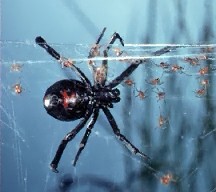
Many spiders overwinter in the soil, mainly leaf litter. Most spiders will assume a rigid posture, with legs drawn close to the body. Some spiders will overwinter as nymphs, some as spiderlings in the egg case, some as adults in an inactive state and some remain active all winter.